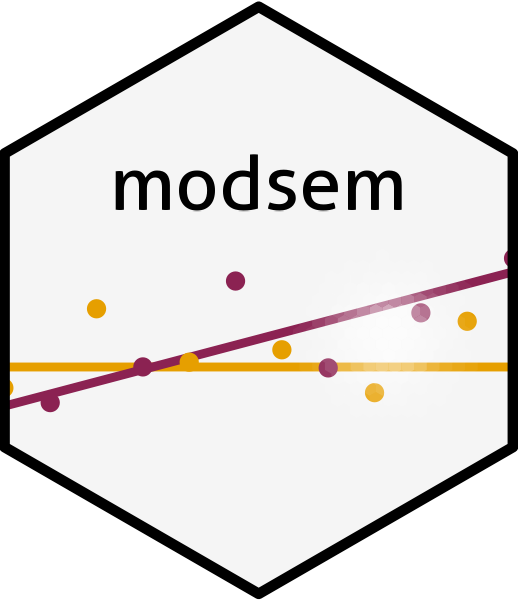modsem is an R-package for estimating interaction (i.e., moderation) effects between latent variables in structural equation models (SEMs). See https://www.modsem.org for a tutorial.
Installation
modsem is available on CRAN and GitHub, and can be installed as follows:
# From CRAN
install.packages("modsem")
# Latest version from GitHub
install.packages("devtools")
devtools::install_github("kss2k/modsem", build_vignettes = TRUE)Note: The package needs to be compiled from source on macOS (if installing via GitHub) and Linux. If you have issues installing the package on macOS, you might need to install the gfortran compiler. A C++ compiler is also required, but should be installed by default on most systems. See the R for macOs page for more information.
If you’re using Windows, consider installing OpenBLAS in R for Windows for better perfmance. If you’re using a Linux distribution, consider installing the ropenblas package
Methods/Approaches
There are a number of approaches for estimating interaction effects in SEM. In modsem(), the method = "method" argument allows you to choose which to use. Different approaches can be categorized into two groups: Product Indicator (PI) and Distribution Analytic (DA) approaches.
Product Indicator (PI) Approaches:
-
"ca"= constrained approach (Algina & Moulder, 2001)- Note that constraints can become quite complicated for complex models, particularly when there is an interaction including enodgenous variables. The method can therefore be quite slow.
-
"uca"= unconstrained approach (Marsh, 2004) -
"rca"= residual centering approach (Little et al., 2006) -
"dblcent"= double centering approach (Marsh., 2013)- default
-
"pind"= basic product indicator approach (not recommended)
Examples
Elementary Interaction Model (Kenny & Judd, 1984; Jaccard & Wan, 1995)
library(modsem)
m1 <- '
# Outer Model
X =~ x1 + x2 + x3
Y =~ y1 + y2 + y3
Z =~ z1 + z2 + z3
# Inner model
Y ~ X + Z + X:Z
'
# Double centering approach
est1_dca <- modsem(m1, oneInt)
summary(est1_dca)
# Constrained approach
est1_ca <- modsem(m1, oneInt, method = "ca")
summary(est1_ca)
# QML approach
est1_qml <- modsem(m1, oneInt, method = "qml")
summary(est1_qml, standardized = TRUE)
# LMS approach
est1_lms <- modsem(m1, oneInt, method = "lms")
summary(est1_lms)Theory Of Planned Behavior
tpb <- "
# Outer Model (Based on Hagger et al., 2007)
ATT =~ att1 + att2 + att3 + att4 + att5
SN =~ sn1 + sn2
PBC =~ pbc1 + pbc2 + pbc3
INT =~ int1 + int2 + int3
BEH =~ b1 + b2
# Inner Model (Based on Steinmetz et al., 2011)
INT ~ ATT + SN + PBC
BEH ~ INT + PBC
BEH ~ PBC:INT
"
# double centering approach
est_tpb_dca <- modsem(tpb, data = TPB, method = "dblcent")
summary(est_tpb_dca)
# Constrained approach using Wrigths path tracing rules for generating
# the appropriate constraints
est_tpb_ca <- modsem(tpb, data = TPB, method = "ca")
summary(est_tpb_ca)
# LMS approach
est_tpb_lms <- modsem(tpb, data = TPB, method = "lms")
summary(est_tpb_lms, standardized = TRUE)
# QML approach
est_tpb_qml <- modsem(tpb, data = TPB, method = "qml")
summary(est_tpb_qml, standardized = TRUE)